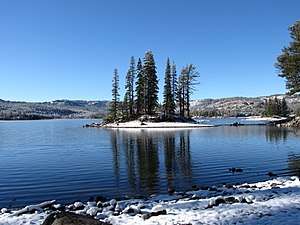Winter in Canada and the United States
Most of Canada and large parts of the United States have cold and potentially snowy winters, posing a challenge to visitors.
Understand
.jpg)
As North American mountain ranges go north-south, weather changes can be rather dramatic, with occasional snowstorms down into the South. As a general principle, the inland (which makes up most of the North American continent) has larger temperature difference between summer and winter than the coast.
The United States uses US customary units for weather reports, including degrees Fahrenheit (°F), and inches of mercury for air pressure. Since 1970, Canada has officially used the metric scale (including degrees Celsius), but imperial units (including °F) are still in traditional use. Near the US-Canadian border, US and metric units are used in parallel. See Metric and Imperial equivalents for details about unit conversions.
Climate zones
Arctic Alaska, much of northern Canada and most of Greenland are within the Arctic, and temperatures are normally below 10 °C year-round. The rest of Alaska and most of Canada have either boreal or sub-Arctic climates, with short summers and long, cold winters. The same applies for the highest parts of the Rocky Mountains in the United States. Southern Canada and most of the contiguous United States (except the south and southwest) have a temperate climate, where winters are short, but can be intensely cold.
The southwestern and southern United States (as well as northern Mexico) have a subtropical climate, where sub-zero temperatures are unusual, but not unheard of. Higher altitudes in these regions (the Appalachians in the southeast, and the various plateaus and mountains of the southwest) will often be much colder. A particularly dramatic contrast by altitude is in Arizona—in the state's capital of Phoenix, freezing weather is rare; but Flagstaff, less than three hours' drive to the north but about 5,800 feet/1,750 m higher, gets regular snowfall and low temperatures below freezing for over 200 days per year. The tropics (Florida, southern California, Hawaii, the Caribbean and Central America) are warm year-round — except for higher altitudes which are not as warm but lack large temperature changes between the seasons.

North America has colder winters than similar latitudes in Europe; on the US-Canada border (which mostly follows the 49th parallel) winter temperature is persistently minus 15 degrees C or colder; Paris and Vienna, which are nearly on the same latitude, are usually above zero. Churchill is roughly the same latitude as Stockholm, but can be 20 °C colder or more in winter.
The Great Lakes create a micro-climate zone; occasionally, the lands east of the lakes can see enormous amounts of snow. The Pacific Coast has mild winters, with plenty of rain during the cold season — although mountain ranges in the region are a different story, and can be cold and snowy in winter. The cities on the coast itself, like Vancouver in Canada and Seattle, San Francisco, and Los Angeles in the United States have mild winters or no winters at all.
Get around
- See also: Winter driving
The United States and Canada are among the world's most car-dependent countries. Urban streets and major highways are usually plowed soon after snowfall; countryside roads are another story.
In the Sierra Nevada Mountains in California, there are several highways that go over the mountain passes, and many of the state routes close during the winter. The passes around Lake Tahoe have lower elevations than those to the south and therefore are less likely to be closed; as you go south, the passes get higher and the roads are likely to be closed for large portions of the year.
See
Many popular American tourist destinations, like Yosemite and the Grand Canyon, get snow in winter. It makes these places look completely different, so if you haven't visited them in winter, that is another option.
Do

North America has many resorts for downhill snowsports, especially in the Rocky Mountains. While ice hockey in North America is associated with winter, the National Hockey League has gravitated towards the South in recent decades.
Events
Christmas is a major holiday in the United States and Canada. A White Christmas is likely in most of Canada, with the exception of coastal British Columbia and southern Ontario.
Stay safe
- See also: Cold weather, Snow safety, Ice safety
The need for precautions varies with location. Cities with regularly long and snowy winters (such as Winnipeg) tend to have better winter utilities than cities such as New York City, where snow and cold temperatures are less common.
Regions colored gold/brown on the map to the right, especially towards the southern end of the map, rarely receive extremely cold weather, with the exception of high mountain peaks, and generally in these regions cold weather is not a major concern.